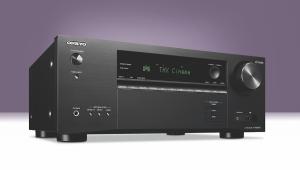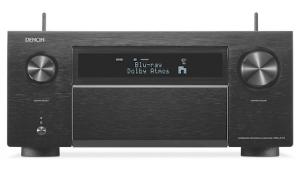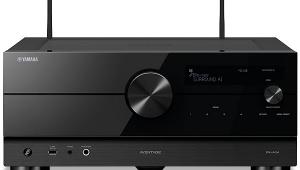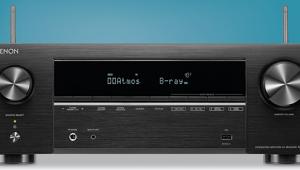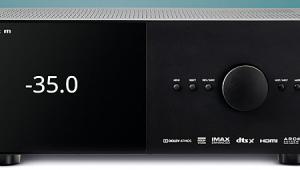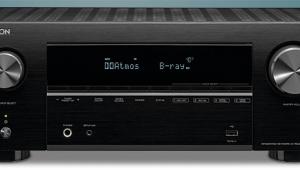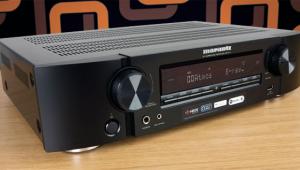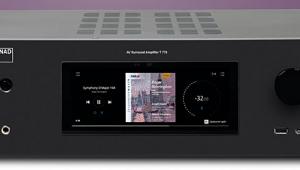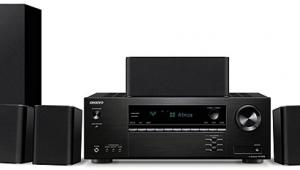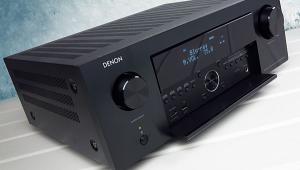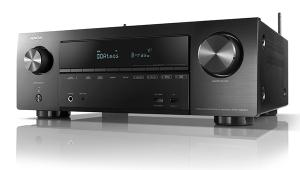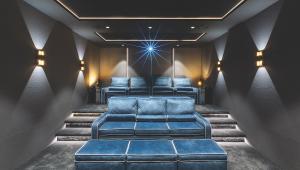McIntosh MHT300 AV receiver review
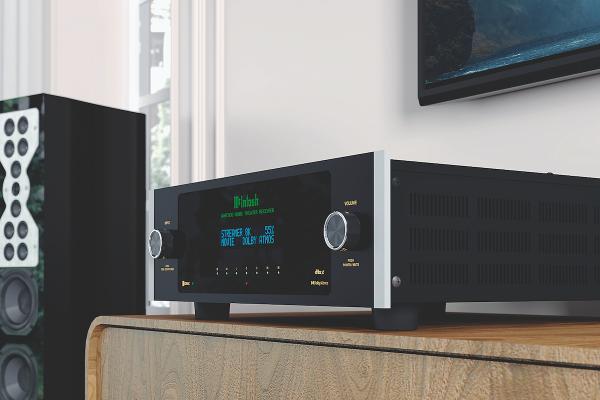
 Steve Withers discovers McIntosh's AVR mixes
old-school know-how with cutting-edge tech
Steve Withers discovers McIntosh's AVR mixes
old-school know-how with cutting-edge techWhat do hippies up to their knees in mud at Woodstock and fans tripping in front of The Grateful Dead's infamous 'Wall of Sound' have in common? Both were experiencing music cranked up to seriously unhealthy volumes thanks to power amplifiers manufactured by US company McIntosh.
Founded by Frank McIntosh and Gordon Gow in 1949 in Maryland, before moving to Binghamton, NY a couple of years later, the brand has built a name for itself over the last seven decades by making powerful high-performance amplifiers that are popular with professionals and consumers alike. The Grateful Dead's sound system was composed of 48 McIntosh MC2300 models, and capable of delivering an eardrum-shattering 28,800W.
And while McIntosh's reputation is primarily based on its iconic amplifiers (including both tube and solid-state designs), the brand has branched out into numerous other areas, including loudspeakers, DACs, turntables, CD players, and media players. It even introduced the first THX-certified AV system in the 1990s.
High-end
Mention the name McIntosh to anyone with even a passing interest in home audio, and two words probably spring to mind: 'gorgeous' and 'expensive'. The new MHT300 seven-channel AV receiver certainly ticks both those boxes with its classy looks and nine-grand price tag.
Obviously, at this price point the MHT300 is aimed at well-heeled home cinema enthusiasts and the high-end custom install market. It's also the only AV receiver in McIntosh's current lineup, although the brand does offers a trio of equally pretty AV processors.
So what do you get for all that wonga? Well, the MHT300 packs seven channels of Class D power, plus it can decode Dolby Atmos and DTS:X at up to 7.2.4 with the help of added power amps. McIntosh stresses the onboard juice is capable of delivering 120W into 8ohm with all seven channels driven simultaneously, rather than pegging that figure to a single-channel (or stereo) measurement.
However, it's a shame there aren't more channels in terms of both amplification and spatial audio decoding. A 7.2.4 setup is sufficient for most, but as this is an aspirational product the channel-count might seem stingy compared to competitors that can run 13- or 15-channel setups.
The MHT300 delivers several 'firsts' for McIntosh. One of these is the inclusion of Dirac Live, which is welcome because it's one of the best room correction systems around. In a nice touch there's a mic stand in the box, but note the supplied microphone itself connects directly to the MHT300 via a 3.5mm jack, so you can't swap it out for a high-quality USB alternative.

Another new feature is the inclusion of HDMI 2.1 connectivity for the first time on a McIntosh AVR, with all connections supporting 8K/60 and 4K/120, along with every flavour of HDR, plus eARC on the output. And, yes, that is output singular, alongside only four HDMI ins. Again, competitor products provide more.
The remaining source options are digital-only, with two optical and two coaxial inputs. There's a USB port but that's only for power or firmware updates, and McIntosh follows the 'performance first' ethos by offering no wireless connectivity. However, Ethernet and RS232 connections are there for installers, along with an IR input and 12V triggers.
Unbalanced RCA inputs and outputs are offered for each of the seven built-in channels, which come pre-fitted with jumper connectors. There are also unbalanced RCA outputs for the four height channels, as well as two dedicated subwoofer outputs.
In terms of other features there's an FM tuner, although you'll need to provide your own aerial, and that's about it. This is an AV receiver that relies on its trademark McIntosh looks, weapons-grade build quality, and performance to justify its price premium, and in this respect it delivers.
Black beauty
It's not often I get to say this about an AVR, but the MHT300 is seriously sexy. The black glass faceplate is gorgeous, with its golden lettering, teal illumination, and silver end plates. This elegant and minimalist design is so beautiful it's a shame that given its target market the MHT300 is probably destined for an equipment rack.
There's a large and informative display in the centre, with lights underneath to indicate which channels are being used, or when Dirac Live, Dolby Atmos and DTS:X are engaged. On either side of the display are identical multi-function dials for control and setup. There's also an equally elegant remote.
Setup either involves the front display in combination with the dials or zapper, or using McIntosh's web-based interface. The latter is definitely the preferred option, laying out all the menu choices in a clear and intuitive fashion.
The inherent simplicity of this receiver makes setup easy. You need to manage the speaker layout and individual crossovers in the menus, but you run Dirac on a laptop connected to the MHT300 over your network. The user-friendly nature of the software makes it a breeze to integrate any subs, balance out the soundstage, and reduce the more egregious aspects of your room.
I initially tested the MHT300 in a 7.2 configuration, before moving on to a 5.2.2 setup, which is the only immersive option available out of the box. I then added four extra channels to get a handle on the receiver's full 7.2.4 object-based capabilities.
Mission to Mars
Kicking things off with the Blu-ray release of the newly restored Ziggy Stardust movie, this AVR didn't disappoint with its rendition of the freshly minted 5.1 soundtrack. It's a full-bodied affair that showcases the Spiders from Mars at the height of their powers in what turned out to be their last live show, and McIntosh's decades of accumulated amplifier experience is obvious in a delivery that's powerful, responsive and revealing. The film's mix is front-heavy, and this AVR expressed it as a visceral wall of sound that attacks you with thumping drums and wailing guitars.
Mick Ronson's solo in 'Moonage Daydream' was nothing short of magnificent, sounding like a caged animal howling to be set free. The percussive kicks on the drums enjoyed expertly timed bass, and the individual instruments could be picked out with ease, especially Woody Woodmansey's over-zealous use of the hi-hat. The handling of Bowie's vocals, from the epic freak-out of 'Width of a Circle' to the delicate acoustic rendition of 'My Death', was equally slick.
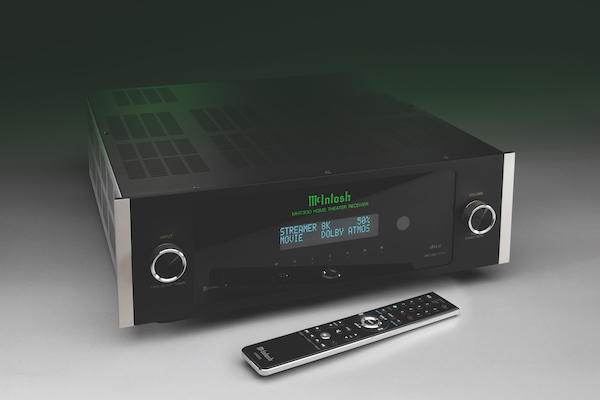
I used my 4K disc of Kong: Skull Island to begin putting the MHT300 through its Atmos paces, but before I go into detail I have a quick observation. While you will get a taste of spatial immersion using 5.1.2, the lack of back speakers leaves a hole in the processing's acoustic bubble. I'd recommend at least a 7.1.2 setup, which makes it a shame that McIntosh hasn't at least gone for nine amp channels.
Anyway, Kong... has a complex Dolby Atmos mix that makes full use of the height layer right from the off. Two dogfighting planes fly all around and above you during the opening credits, before both crash from overhead in spectacular fashion. As their two pilots face off against one another, the titular ape makes a dramatic entrance, accompanied by a massive front soundstage that's underscored by prodigious amounts of LFE.
This receiver proved capable of creating an exhilarating sense of scale, even when all seven channels are driven simultaneously. There's a maturity to the delivery here, a clean and clear sound, plus sufficient headroom to ensure the simian bedlam is handled without breaking a sweat.
Towards the film's climax Samuel L. Jackson sets a trap for the monster monkey by surrounding him in flames, but soon realises he's bitten off more than he can chew as Kong towers over him. The MHT300 did a fantastic job of picking out the sounds of burning jungle, while the heights were effectively used to bring added scale to Kong as he dwarfs his human opponent.
Rome destroyed in a day
A more recent addition to my collection is Fast X (4K BD). While you wouldn't expect a subtle soundtrack from any film in this franchise, the opening Rome set-piece is a tour de force of manic sonic design. As a giant metal ball bomb bounces around the city, Dom and crew race around the streets in a desperate attempt to stop it.
The whole sequence plays out like it was designed by a kid on a diet of fizzy pop and Skittles, and the soundtrack complements the mayhem with joyous abandon. Through the MHT300, all the channels were filled with revving engines and squealing tires, while each bounce of the bomb was enhanced by a hefty bass bump.
Dirac certainly plays its part in creating a soundscape that's composed and balanced despite all the carnage, with a smooth low-end that's nicely integrated. When the bomb actually explodes there's a wave of low-frequency energy that spreads out through the room, and the ability to set crossovers for each speaker allows them to seamlessly hand off to the subs in the system.
Power up
McIntosh's MHT300 is an outstanding multichannel AV receiver, capable of generating a complex and powerful soundstage with an emphasis on sheer scale. Its amplification is highly responsive to dynamic peaks, and the whole performance is shot through with clarity and precision. It's a real shame more channels aren't built in, though, and the price of entry is high...
HCC Verdict: 4.5/5
McIntosh MHT300
Price: £8,995
www.mcintoshlabs.com
We say: This classy AV receiver lacks a few features found on more affordable competitors, but there's no denying its sonic pedigree as it effortlessly delivers exhilarating soundscapes.
Specifications
DOLBY ATMOS: Yes DTS:X: Yes IMAX ENHANCED: No MULTICHANNEL INPUT: No MULTICHANNEL PRE-OUT: Yes. 11.2 MULTICHANNEL OUTPUT (CLAIMED): 7 x 120W (into 8 ohms, all channels driven, 20Hz-20kHz, 0.05% THD)) MULTIROOM: No HDMI: Yes. 4 x inputs; 1 x output AV INPUTS: 4 x digital audio (2 x optical and 2 x coaxial) DIMENSIONS: 445(w) x 508(d) x 157(h)mm WEIGHT: 12.2kg
FEATURES: Class D amplification; web-based setup and control; Dirac Live room correction; FM tuner; microphone and stand supplied; IR input; 2 x 12V trigger; Ethernet; USB port (service); RS232; HDM1 2.1 with HDCP 2.3, 8K/60, 4K/120, HDR10, HLG, HDR10+ and Dolby Vision passthrough; bass and treble tone controls; Power Guard signal overload sensing; Sentry Monitor short-circuit protection; 7 x 32-bit DACs
 |
Home Cinema Choice #351 is on sale now, featuring: Samsung S95D flagship OLED TV; Ascendo loudspeakers; Pioneer VSA-LX805 AV receiver; UST projector roundup; 2024’s summer movies; Conan 4K; and more
|




